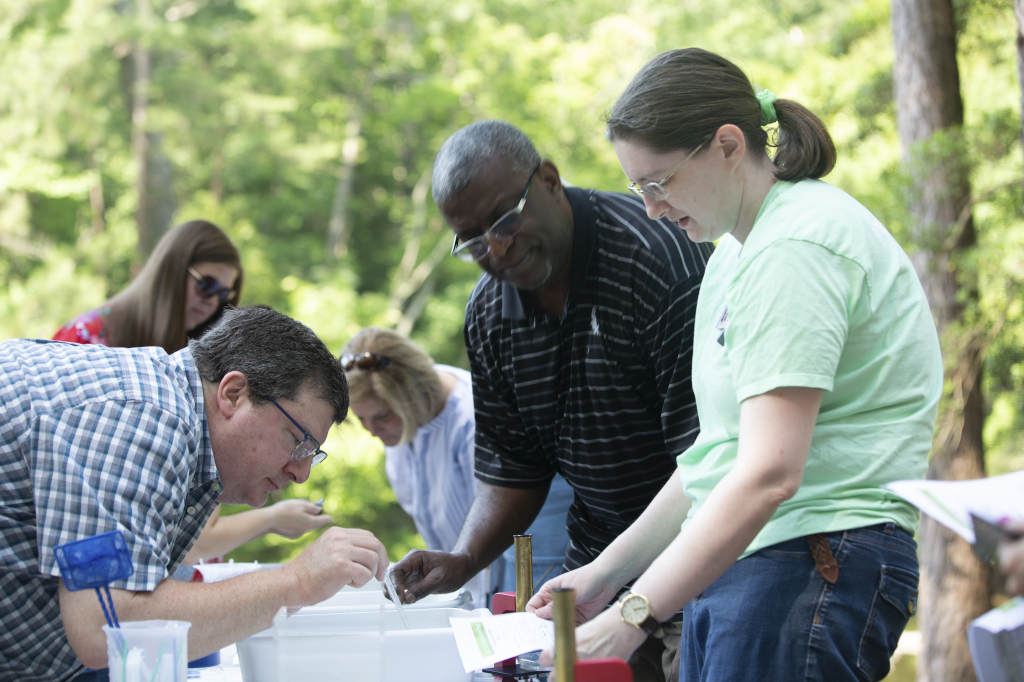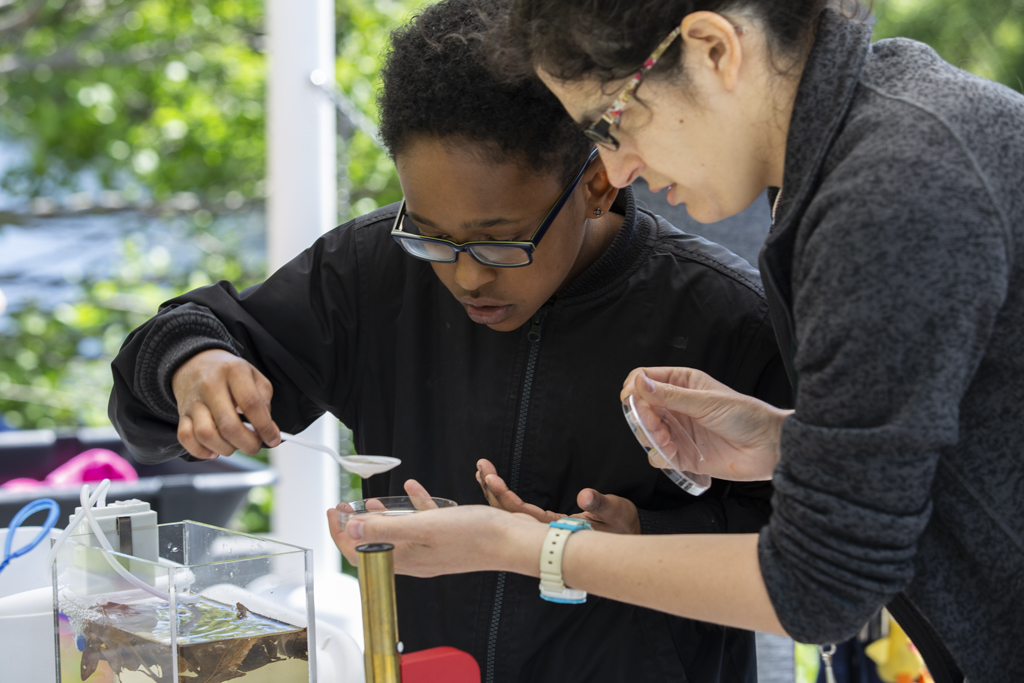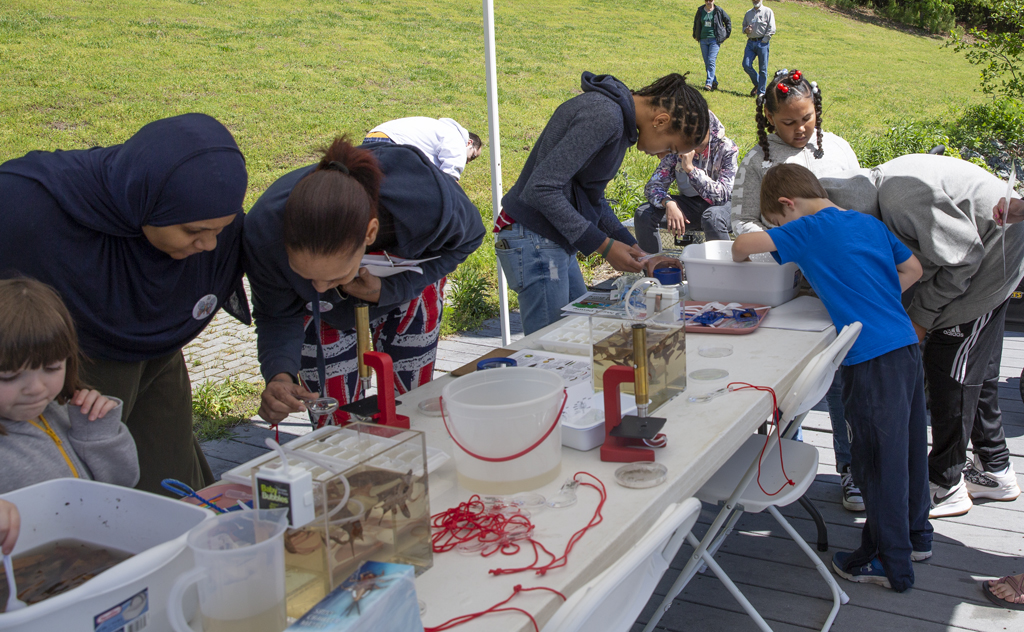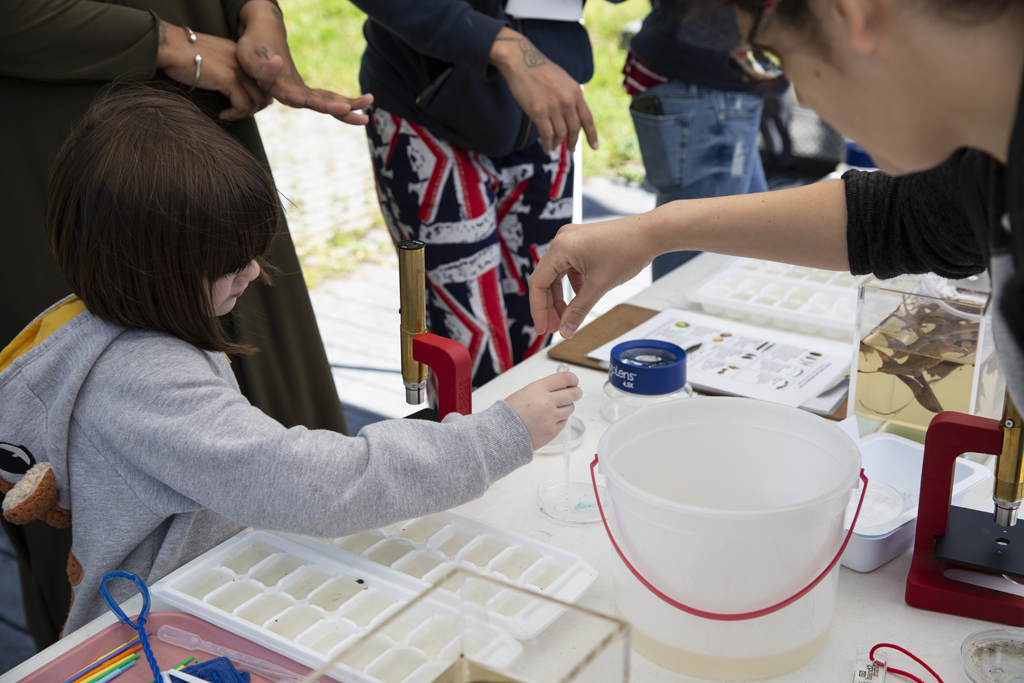A biodiverse watershed
The Mariners’ Museum Park is 550 acres of lake and forested land brimming with wonder and diversity. Our very own Chesapeake Bay is considered to be ecologically diverse, and The Mariners’ Museum Park, located right off the James River, is a microcosm of that spectacular diversity. With our most current datasets from a combination of research from local universities, government entities, citizen science efforts, and our own internal data collection, we know the Park has approximately 96 species of trees, 187 bird species, 88 herbaceous and woody plant species, and a plethora of insects, amphibians, reptiles, fungi, and so much more. With more of a focus on the Park in recent years across many Museum departments, there has been a concerted effort to increase programming and informational sessions that pertain to the Park’s living collection and the Park’s history. If you want to learn more about the Park history, watch out for blog posts from Erica Deale, the Park Stewardship Coordinator.
Education Department Programs
The Education Department at the Museum has also been building upon the fantastic natural resource of the Park. Since 2018, the Education Department has expanded our Park-focused program offerings along with collaborating with local environmental and citizen science groups in development, implementation, and/or funding. In this blog, I’m just focusing on one of our outdoor programs called Macroinvertebrate Mayhem that was co-developed with the Virginia Institute of Marine Science (VIMS).
If you’re familiar with watershed education in Virginia, then you’ve likely heard of the term “meaningful watershed educational experience,” otherwise known as MWEE. MWEEs are multiple, impactful educational experiences and projects that focus on student investigation, exploration, and experimentation around the Chesapeake Bay watersheds. MWEEs encourage critical thinking and teach important skills including scientific investigation.
As an Environmental Geologist, I know first hand the importance of getting students out in the field to learn challenging concepts and natural phenomena. The MWEE immersive sessions also begin the process of building scientific experiences such as gathering and analyzing data. Taking students through the various steps of a scientific investigation in a hands-on atmosphere is a great place to start their minds churning and thinking more critically about how the world around them works.
In the Mariners’ Museum Education Department, our hope is that the various outdoor programs we offer assist in fulfilling MWEEs for school requirements and facilitate education outside in our amazing watersheds, but as well to encourage life-long learning and appreciation of the natural world, including our urban oasis of The Mariners’ Museum Park.

Water quality has been a theme for outdoor science programming at the Mariners’ previously especially because we have Mariners’ Lake and the James River in our backyard. Offering programs about water quality at TMMP is important in that we are taking the time to teach the community about the health of our fragile and valuable waterways.
In recent years the Education Department has expanded our outdoor watershed programming to include biological investigation. Macroinvertebrate Mayhem is one of our newer outdoor programs that was developed in collaboration with VIMS. This program has been a success with upper elementary to high school students and even families at our larger events like Celebrate the Park.
What are those weird critters anyway?!
You probably saw the name Macroinvertebrate Mayhem, and thought, what is that? First of all, what does macroinvertebrate mean? Macro means large enough to see with the naked eye, and invertebrate means an animal without a backbone.
The macroinvertebrates we are looking at in this student investigation are all aquatic, meaning they live in the water. Some critters live their whole lives in the water, like clams, mussels, and water boatmen, and some only live part of their developmental lives in the safety of the water, such as dragonflies, mayflies, and dobsonflies.
The water is a whole other magical and awe-inspiring world most of us are not so familiar with, so needless to say, the different types of invertebrates in freshwater, like in Mariners’ Lake, are vast. Some of the many, many fascinating critters who call Mariners’ Lake their home are: clams, crayfish, mites, snails, dragonflies, stoneflies, mayflies, caddisflies, black flies, and midge flies.
The nonliving elements of the lake ecosystem (the water, the leaf litter, sediment, and even the geomorphology of the water body) offer shelter, space, and food for many macroinvertebrates (and of course aquatic vertebrates like fish).
How does this program work? Leaf packs (mesh bags full of leaves) are submerged in certain locations of Mariners’ Lake a few weeks ahead of time. When the day comes for the program, the instructor retrieves the leaf packs for student investigation onshore. (The critters are released back into the water after the investigation– so don’t worry!) The leaf litter acts as a great source for protection and sometimes food for the macroinvertebrates.
To me, these leaf packs are like temporary hotels or shelters in the water where our macroinvertebrates can congregate and stay safe from predators. Students sort through the leaf litter and record the animals they see. They refer to a simplified dichotomous key of benthic freshwater macroinvertebrates to help identify the critters, especially new ones that look like tiny creatures from another planet.
In the past, we’ve found exciting critters like helgramites, snails, leeches, mayflies, aquatic worms, and so much more. At the end of the sorting, everyone comes back together and shares data from each leaf pack. The macroinvertebrates are important to study in that they act as a bioindicator, which is simply a living indicator for lake pollution in our case. The presence or absence of certain insects, that are ranked on a pollution tolerance scale, along with the diversity of macroinvertebrates found, act like a canary in a coal mine for pollution.
Some of the pollutants that might come into the water are from sources like fertilizers, fossil fuels from vehicles, or even too much sediment washed in from the surrounding watershed. The living indicators are compared to the chemical and physical indicators the students also tested for. Ultimately, these data (biotic and abiotic) indicate poor, fair, good, or excellent water quality for freshwater.
Why does a program like this matter? As mentioned previously, it’s not just a great hands-on way to learn about macroinvertebrates and scientific investigation, but it can be linked to important current events in the scientific community and beyond.
What’s the scoop on insects?
A recent topic on the lips of many environmental scientists is the concerning “insect apocalypse.” NBC News reports that studies around the world have indicated a 27% global insect decline over the past three decades. These studies have been exclusively looking at land-dwelling insects, however what about aquatic insects? Certain species are in fact seeing a drop in numbers.
According to research from authors Sánchez-Bayoa and Wyckhuys, who compiled and analyzed data from 73 historical reports of insect decline globally from numerous countries and regions, it was concluded that over 40% of the studied land and aquatic insects have seen population declines. Certain aquatic insects highlighted in the research experiencing population declines are dragonflies and damselflies (Odonata), mayflies (Ephemeroptera), caddisflies (Trichoptera), and stoneflies (Plecoptera). Sánchez-Bayoa and Wyckhuys explain that freshwater aquatic insects usually have an inflexible life cycle, and many of these insects only have one brood of offspring per year.
These factors ultimately mean aquatic insects are more sensitive to environmental changes including habitat fragmentation, changes in fluvial conditions, invasive species, pollution, and climate change. We are seeing a global insect decline, and it is very worrisome.
Though insects don’t have a backbone, they really are the backbone of our ecosystem.
Insects are not studied as well as other animals, and more studies need to be performed to help understand the details of the population issues locally and globally. While studies like the ones mentioned previously and many others do show a global decline, there are also studies, like that of Klink et al., that also indicates a decrease in insect populations, but the analysis additionally shows an increase only in certain populations in certain localities. Some of the increase in this study applies to aquatic macroinvertebrates. The population increase of aquatic insects is attributed to many local factors, including stronger clean water laws over the past decades. However, if the clean water laws are weaker or disappear, then this population surge, if attributed to clean water, likely won’t last long.
The insect population increases and decreases in the world are without a doubt far more nuanced than we realize. Insects and other macroinvertebrates are vital to our ecosystems in so many ways. Why do insects matter? They help dispose and break down dead animal and plant matter. They are a significant protein source for many animals. Don’t forget, those insects that developed in the water and then move to the land, can be pollinators, like flies and beetles, so they help in the effort to pollinate our plants locally. Imagine a world without dragonflies– who would eat all those mosquitos? Without insects, our world would be totally different, and not for the better.
A program like Macroinvertebrate Mayhem is just a small opening to a whole wide world of wonder that might inspire the next generation of entomologists and environmental scientists!
Once The Mariners’ Museum and Park is open again for booking programs, please investigate our Education website to see options for book Macroinvertebrate Mayhem or the other outdoor programs, like What’s in My Water: A Watershed Investigation.
If you want to learn more about leaf packs and how they can be used in watershed education, please check out the Leaf Pack Network (https://leafpacknetwork.org/)
If you want to learn more about how freshwater insects are “Global Insect Declines: 33% of Aquatic Species Threatened with Extinction.” The Freshwater Blog, February 15, 2019. https://freshwaterblog.net/2019/02/15/global-insect-declines-33-of-aquatic-species-threatened-with-extinction/.
Klink, Roel van, Diana E. Bowler, Konstantin B. Gongalsky, Ann B. Swengel, Alessandro Gentile, and Jonathan M. Chase. “Meta-Analysis Reveals Declines in Terrestrial but Increases in Freshwater Insect Abundances.” Science. American Association for the Advancement of Science, April 24, 2020. https://science.sciencemag.org/content/368/6489/417.
Noaa. “Chesapeake Bay.” NOAA. Accessed May 8, 2020. https://www.fisheries.noaa.gov/topic/chesapeake-bay.
Press, Associated. “Earth’s Insect Population Shrinks 27 Percent in 30 Years.” NBCNews.com. NBCUniversal News Group, April 24, 2020. https://www.nbcnews.com/news/world/earth-s-insect-population-shrinks-27-percent-30-years-n1191516?utm_source=Science_on_Tap&utm_medium=email&utm_campaign=SoT-24235&et_rid=104392492&et_cid=3310820.
Sánchez-Bayo, Francisco, and Kris A.G. Wyckhuys. “Worldwide Decline of the Entomofauna: A Review of Its Drivers.” Biological Conservation. Elsevier, January 31, 2019. https://www.sciencedirect.com/science/article/pii/S0006320718313636#f0010.


